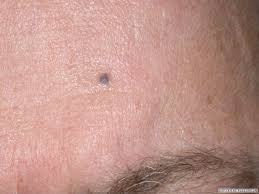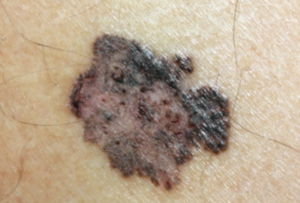Ever see images of melanoma and wonder why some of the lesions have purple areas?
Perhaps you’ve seen photos in which the entire melanoma was purple.
About one-third of melanomas arise in a pre-existing mole, and the disease can cause areas of the mole to appear some shade of purple or even mauve.
A tumor that begins in the absence of a mole may, too, have purplish areas.
The purple isn’t actually the melanoma itself. Rather, it’s an illusion called the Tyndall effect.
“Because of the Tyndall effect, as melanin pigment accumulates below the skin’s surface, it can appear blue instead of brown,” says Adarsh Vijay Mudgil, MD, double board certified in dermatology and dermatopathology, and founder of Mudgil Dermatology in NY.
“The deeper and more dense the pigmentation is, the more bluish/purplish the lesion can appear,” says Dr. Mudgil.
It’s important to know that a benign mole may also appear purple, violet or blue, due to this same effect.

In no way does this mean that the normal mole is at greater risk for becoming malignant.
What actually happens in the Tyndall effect?
The brown pigment absorbs the longer wavelengths of light, and scatters and reflects it as blue light. This may appear more purple than blue.
The disease itself does not cause the purple. It’s the way the light enters and is scattered by the lesion.
The prognosis of a melanoma is determined by its thickness and depth (and any invasion into lymph nodes or distant body parts), and not by its color.
The color can present as any of the following: white, grey, beige-yellow, tan, brown, black, magenta, maroon, red, pink, blue, violet and of course…purple.


 Dr. Mudgil
Dr. Mudgil 







































